
views
Understanding the Basics

Understand the difference between an algebraic expression and an algebraic equation. An algebraic expression is a mathematical phrase that can contain numbers and/or variables. It does not contain an equals sign and cannot be solved. An algebraic equation, however, can be solved, and does include a series of algebraic expressions separated by an equals sign. Here are some examples: Algebraic expression: 4x + 2 Algebraic equation: 4x + 2 = 100

Know how to combine like terms. Combining like terms just means adding up (or subtracting) the terms of the same degree. This means that all x terms can be combined with other x terms, that all x terms can be combined with x terms, and that all constants, numbers that are not attached to variables, such as 8 or 5, can be added up, or combined, as well. Here's an example: 3x + 5 + 4x - x + 2x + 9 = 3x - x + 4x + 2x + 5 + 9 = 2x + 6x + 14
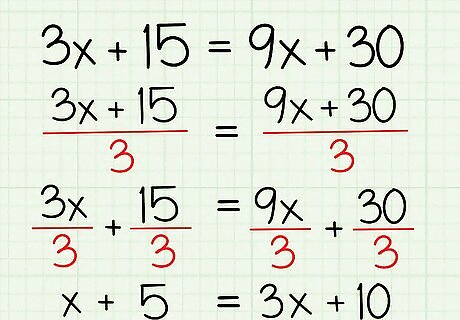
Know how to factor a number. If you're working with an algebraic equation, which means there is an expression on either side of an equals sign, then you can simplify it by factoring out a common term. Look at the coefficients of all of the terms (the numbers before the variables, or the constants) and see if there is a number that you can "factor out" by dividing each term by that number. If you can do this, then you have simplified the equation and are on your way to solving it. Here's how: 3x + 15 = 9x + 30 You can see that each coefficient can be divisible by 3. Just "factor out" the number 3 by dividing each term by 3 to get your simplified equation. 3x/3 + 15/3 = 9x/3 + 30/3 = x + 5 = 3x + 10
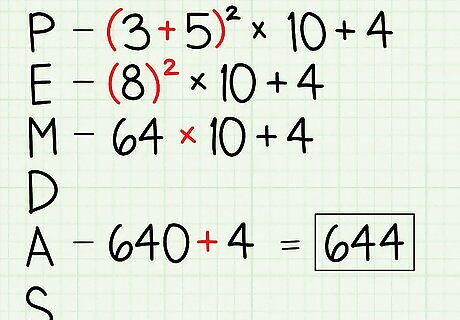
Know the order of operations. The order of operations, also known by the acronym PEMDAS, explains the order in which you should perform different mathematical operations. The order is: Parentheses, Exponents, Multiplication, Division, Addition, and Subtraction. Here's an example of how the order of operations works: (3 + 5) x 10 + 4 First, follow P, the operation in the parentheses: = (8) x 10 + 4 Then, follow E, the operation of the exponent: = 64 x 10 + 4 Next, do multiplication: = 640 + 4 And last, do addition: = 644
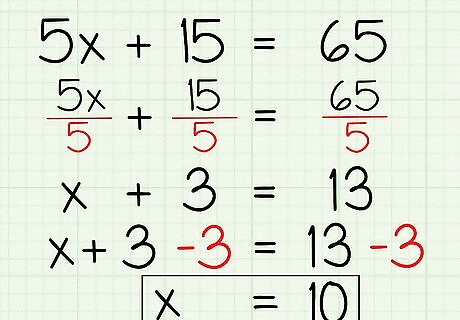
Learn how to isolate a variable. If you're solving an algebraic equation, then your goal is to get the variable, often known as x, on one side of the equation, while placing the constant terms on the other side of the equation. You can isolate x by division, multiplication, addition, subtraction, finding the square root, or other operations. Once you've isolated x, you can solve for it. Here's how: 5x + 15 = 65 = 5x/5 + 15/5 = 65/5 = x + 3 = 13 = x = 10 EXPERT TIP Joseph Meyer Joseph Meyer Math Teacher Joseph Meyer is a High School Math Teacher based in Pittsburgh, Pennsylvania. He is an educator at City Charter High School, where he has been teaching for over 7 years. Joseph is also the founder of Sandbox Math, an online learning community dedicated to helping students succeed in Algebra. His site is set apart by its focus on fostering genuine comprehension through step-by-step understanding (instead of just getting the correct final answer), enabling learners to identify and overcome misunderstandings and confidently take on any test they face. He received his MA in Physics from Case Western Reserve University and his BA in Physics from Baldwin Wallace University. Joseph Meyer Joseph Meyer Math Teacher To solve an equation for a variable like "x," you need to manipulate the equation to isolate x. Use techniques like the distributive property, combining like terms, factoring, adding or subtracting the same number, and multiplying or dividing by the same non-zero number to isolate "x" and find the answer.
Solve an Algebraic Equation
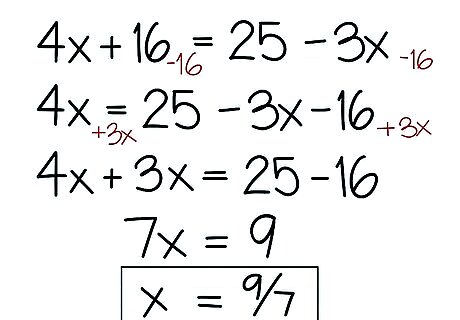
Solve a basic linear algebraic equation. A linear algebraic equation is nice and simple, containing only constants and variables to the first degree (no exponents or fancy stuff). To solve it, simply use multiplication, division, addition, and subtraction when necessary to isolate the variable and solve for "x". Here's how you do it: 4x + 16 = 25 -3x = 4x = 25 -16 - 3x 4x + 3x = 25 -16 = 7x = 9 7x/7 = 9/7 = x = 9/7

Solve an algebraic equation with exponents. If the equation has exponents, then all you have to do is find a way to isolate the exponent on one side of the equation and then to solve by "removing" the exponent by finding the root of both the exponent and the constant on the other side. Here's how you do it: 2x + 12 = 44 First, subtract 12 from both sides. 2x + 12 -12 = 44 -12 = 2x = 32 Next, divide both sides by 2. 2x/2 = 32/2 = x = 16 Solve by taking the square root of both sides, since that will turn x into x. √x = √16 = State both answers:x = 4, -4
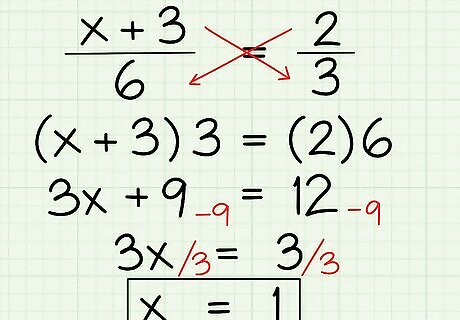
Solve an algebraic expression with fractions. If you want to solve an algebraic expression that uses fractions, then you have to cross multiply the fractions, combine like terms, and then isolate the variable. Here's how you would do it: (x + 3)/6 = 2/3 First, cross multiply to get rid of the fraction. You have to multiply the numerator of one fraction by the denominator of the other. (x + 3) x 3 = 2 x 6 = 3x + 9 = 12 Now, combine like terms. Combine the constant terms, 9 and 12, by subtracting 9 from both sides. 3x + 9 - 9 = 12 - 9 = 3x = 3 Isolate the variable, x, by dividing both sides by 3 and you've got your answer. 3x/3 = 3/3 = x =1
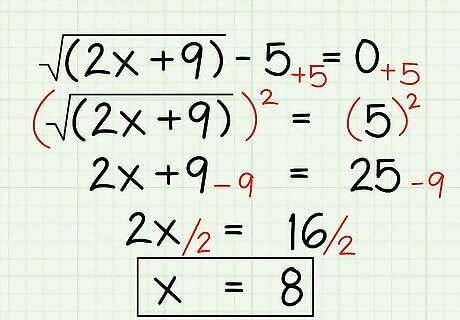
Solve an algebraic expression with radical signs. If you're working with an algebraic expression with radical signs, all you have to do is find a way to square both sides so you can "get rid" of the radical sign and solve for the variable. Here's how you do it: √(2x+9) - 5 = 0 First, move everything that isn't under the radical sign to the other side of the equation: √(2x+9) = 5 Then, square both sides to remove the radical: (√(2x+9)) = 5 = 2x + 9 = 25 Now, solve the equation as you normally would by combining the constants and isolating the variable: 2x = 25 - 9 = 2x = 16 x = 8
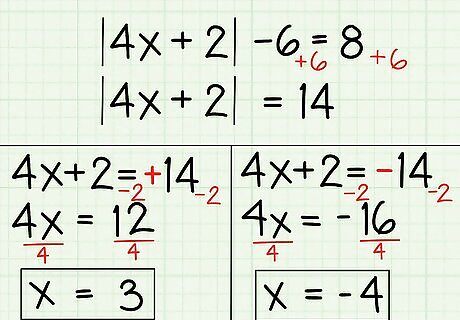
Solve an algebraic expression that contains absolute value. The absolute value of a number represents its value regardless of whether it is positive or negative; the absolute value is always positive. So, for example, the absolute value of -3 (also known as |3|), is simply 3. To find the absolute value, you have to isolate the absolute value and then solve for x twice, solving both for x with the absolute value simply removed, and for x when the terms on the other side of the equals sign have changed their signs from positive to negative and vice versa. Here's how to do it: Here's how you solve for the absolute value by isolating the absolute value and then removing it: |4x +2| - 6 = 8 = |4x +2| = 8 + 6 = |4x +2| = 14 = 4x + 2 = 14 = 4x = 12 x = 3 Now, solve again by flipping the sign of the term on the other side of the equation after you've isolated the absolute value: |4x +2| = 14 = 4x + 2 = -14 4x = -14 -2 4x = -16 4x/4 = -16/4 = x = -4 Now, just state both answers: x = -4, 3
















Comments
0 comment